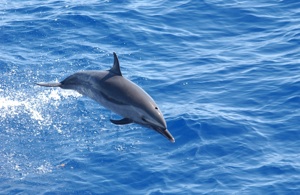Marine Mammal Species Description
Pantropical Spotted Dolphin
Stenella attenuata
(Gray, 1846)

Photo credit: Wayne Hoggard NOAA/NMFS/SEFSC
Classification
Order: Cetacea
Family: Delphinidae
Alternate Common Names: Spotter, spotted porpoise
Status: MMPA Depleted
Description:
Length: 5-8.5 ft (1.6-2.6 m)
Weight: up to 260 lbs (119 kg)
Adult pantropical spotted dolphins have a long beak with a white tip and spots. Their dorsal fin is falcate and they have a long beak with a distinct crease between their melon and their beak. They also have a ?cape? of color on their backs, which is a dark area extending from the top of their head down their back and onto their sides and up onto their back half way between their dorsal fin and their tail.
Habitat:
In the Atlantic, pantropical spotted dolphins are seen most often in the ?high seas?, in deep water away from land. In the Pacific, there are two subspecies, a smaller-bodied subspecies found farther from shore and a larger-bodied subspecies found closer to shore in shallower waters. They occur in schools of a few individuals to thousands of individuals. More typical groups are 50-200 individuals. They are commonly seen in groups with other dolphins.
Feeding:
Pantropical spotted dolphins eat fish, squid, and crustaceans. Researchers have documented them diving for up almost 3.5 minutes at a time.
Reproduction:
Female pantropical spotted dolphins reach sexual maturity at 9-11 years old. Males reach sexual maturity around 12-15 years. The gestation period lasts approximately 11 months. Females give birth to a single calf every two to three years. Calves nurse for one to two years, and calves start to eat solid foods when they are three to six months old.
Other:
Pantropical spotted dolphins commonly ride the waves at the bows of ships. The maximum documented life span of a spotted dolphin is 46 years. In the Pacific pantropical spotted dolphins are known for swimming with yellowfin tuna. This fact is common knowledge among tuna fisherman and has been used in the past to locate schools of tuna. Because of this practice, millions of spotted dolphins have been killed while commercial fisherman use purse seines, large fishing nets, to capture tuna.
Distribution / Range:
Pantropical spotted dolphins occur in tropical waters and some subtropical waters around the globe. In the Pacific, they occur off of the coast of southern California. In the Atlantic, they occur occasionally as far north as New England and are more abundant farther south including the Gulf of Mexico.
Similar species:
Pantropical spotted dolphins can be distinguished from other dolphins in the genus Stenella, because they have spots and a distinctive cape, described above.
Notes:
References:
American Cetacean Society. 2004. American Cetacean Society Fact Sheet. http://www.acsonline.org/factpack/SpottedDolphin.htm. Accessed January 2012.
Culik, B. 2010. Odontocetes. The toothed whales: "Stenella attenuata". UNEP/CMS Secretariat, Bonn, Germany. http://www.cms.int/reports/small_cetaceans/index.htm. Accessed January 2012.
Hammond, P.S., Bearzi, G., Bjørge, A., Forney, K., Karczmarski, L., Kasuya, T., Perrin, W.F., Scott, M.D., Wang, J.Y., Wells, R.S. & Wilson, B. 2008. Stenella attenuata. In: IUCN 2011. IUCN Red List of Threatened Species. Version 2011.2. www.iucnredlist.org. Downloaded on 09 January 2012.
Perrin, W.F. 1999. Pantropical spotted dolphin, Stenella attenuata. In The Smithsonian Book of North American Mammals. Wilson, D.E. and S. Ruff, eds., 265-267. Smithsonian Institution in association with the American Society of Mammologists, Washington DC.
Perrin, W.F. 2009. Pantropical Spotted Dolphin - Stenella attenuata and D. capesis. In: Encyclopedia of Marine Mammals 2nd Ed. Perrin W.F., B. Würsig, and J.G.M. Thewissen, eds. Academic Press, New York, pp. 819-821.

 Marine Mammals of Georgia
Marine Mammals of Georgia